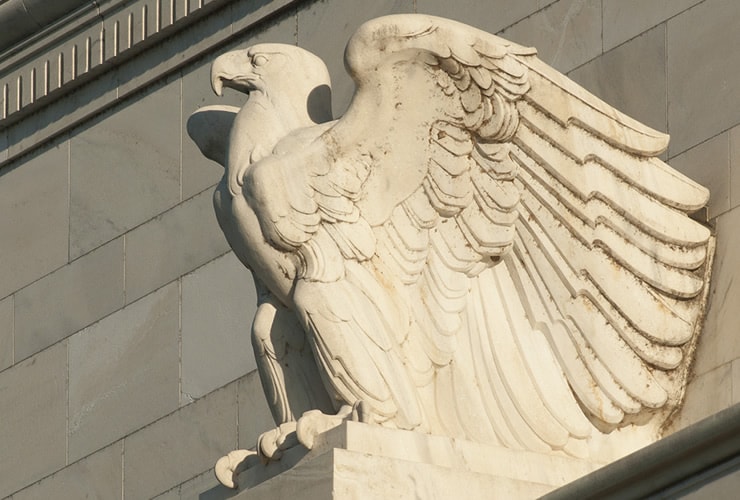US Dollar Reactions through the Federal Reserve Meeting

The US Federal Reserve's Open Markets Committee meets in Washington on December 14 to discuss the setting of interest rates. Here is how the Dollar could react.
Surprises, revolutions, revaluations and acts of God are the ‘four horses of the apocalypse’ for financial markets.
In a word the “unforeseen”.
If investors can see it coming they have time to prepare and prices adjust before the event.
That’s why the Dollar is unlikely to be moved much by the interest rate rise that has already been priced in by market on an almost 100% certainty.
The biggest response would come from the Fed deciding not to adjust interest rates - and that is highly unlikely.
The Dollar would plummet if the Fed shied away from raising rates.
Still, it’s not completely impossible: note the poor earnings data contained in the November jobs report.
Whilst slowing wages was not seen as a game-changer, it will have given Fed governor Yellen food for thought.
Nevertheless, the bottom line is that there is going to be a Fed rate hike, so if not that, then what could move FX on the day?
Future Expectations
Given a rate hike is already something of a foregone conclusion, markets will be looking to formulating an idea of how many rate rises the Fed is likely to make in 2017, say analysts at Bank of America Merill Lynch (BOFAML) in a note to clients:
“Similar to the market response after the December 2015 hike, the key for the FX market will be the signal of the pace of hikes in 2017 and 2018.
“The main determinant here will be the dot plots, statement press conference tone as well as any nod (implicit or explicit) to the recent tightening of financial conditions amidst higher yields and a stronger USD."
Plotting a Course
The Federal Reserve ‘Dot Plot’ will be key in determining the market’s reaction to the event.
The Dot Plot is a chart published on the Fed website which shows when each member expects the Fed to raise interest rates in the future, it is updated at key meetings.
BofAML do not expect a change in the Dot Plot from September, however, they see a higher chance of the dots rising than falling, reflecting greater expectations amongst members of higher interest rate levels in the future.
BofAML’s Athanasios Vamvakidis notes:
“There is a better chance of a move higher than lower in the trajectory.
“We think the dots for next year are the most vulnerable – by our calculation, only 2 members need to shift the dots higher to move up the median expectation for 2017.
“It is possible that stronger Q3 GDP growth and a drop in the unemployment rate have prompted some members to adjust their forecast."
Any move up in the dots would lead to an appreciation in the US Dollar.
Economic Forecasts
The Fed’s own forecasts are adjusted at each meeting and reflect their outlook for the economy.
For this reason, a change in forecasts could be another driver the US Dollar at the meeting.
The recent strong run of strong GDP and Unemployment data is likely to prompt the Fed to raise their own forecasts at the meeting
BOFAML think they will revise down their Unemployment rate forecasts to 4.7% this year and GDP to 1.9 or 2.0% for 2016.
Such an upward revision would also support the Dollar on the day.
Wording of Statement
The wording of the Fed’s accompanying statement is likely to be changed according to Vamavakidis’ base case scenario.
The reference to the “balance of risks” will probably be changed to something more neutral with “roughly balanced” being condensed to a less ambiguous “balanced”.
The Fed may not show wholehearted commitment to a course of rate hikes yet, and, “will still note that the stance of monetary policy remains accommodative,” says Vamvakidis.
The Fed is likely to remove the reference to a risk of inflation shortfall from tis 2.0% target:
“We expect tweaks to this paragraph to remove the reference to the shortfall in inflation from the 2% target as a reason for remaining cautious.
The combination of the drop in the unemployment rate and rise in inflation expectations as well as the upward trend in realized inflation will likely leave the Fed feeling more comfortable with inflation risks,” commented Vamvakidis.
Tone of Commentary
BOFAML expect the Fed Chairwomen to steer clear of an outright ‘hawkish’ tone (hawkish means supporting further rate hikes in the future) in the press conference after the meeting, and to adopt a “cautiously optimistic” tone, “reiterating the gradual pace of rate hikes,” instead.
The word “gradual” may be key as if it is jettisoned, this would indicate a much faster rate of interest rate hikes, which would be very Dollar-positive.
The greater likelihood is that Yellen will emphasize the need for ‘carful risk management’ in raising rates, since increasing them too quickly could cut off the fragile recovery.
BOFAML’s Vamvakidis thinks Yellen may also be asked about the fiscal policy and that she is likely to suggest a focus on increasing productivity.
She may highlight the risks of rising government debt from its already high 77% of GDP.
She is likely to advise that regulation brought in since the crisis be defended to protect the financial system from future shocks.




